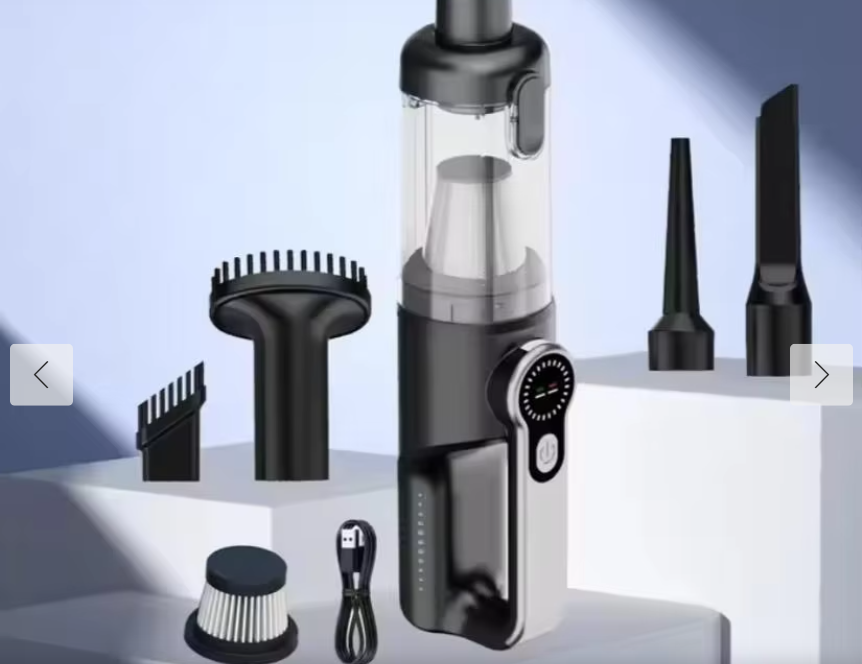Essential Components of a Car Vacuum Cleaner
Understanding the Motor and Suction System
At the core of any car vacuum sits the motor, which kicks off the whole suction process that pulls dirt and grime out of seats and carpets. When shopping around, people often notice that vacuums with better motors tend to clean much more thoroughly. Why? Well, how strong the suction gets really comes down to two main things: how the motor is built and how fast it spins those revolutions per minute. Motors that spin faster generally do a better job at picking up messes from hard to reach spots. Getting a handle on airflow versus actual suction power makes all the difference when someone wants to find the right vacuum for their particular cleaning situation. After all, nobody wants to battle with dust bunnies stuck under the back seat after a quick clean.
Importance of Filters and Dust Containers
The filters inside car vacuums do a pretty good job at catching all sorts of stuff like dust, pollen, and those tiny particles floating around. People who suffer from allergies might want to go for HEPA filters specifically since they're better at trapping those pesky allergens. When these filters work properly, they help keep the air coming out of the vacuum cleaner actually clean instead of just moving dirty air around. Don't forget about the dust container either! If left unchecked, it gets clogged up fast which means the whole system starts working harder than necessary. Some folks prefer bagged systems while others stick with bagless models. Bagged ones tend to hold more dirt but require replacing bags regularly. Bagless models need emptying more frequently but save money on replacement costs long term. Pick whatever fits into your regular cleaning routine best.
Hoses, Attachments, and Accessories
Car vacuums come with all sorts of attachments that make cleaning so much easier. Crevice tools work wonders for those tight spaces between seats, while brush heads handle upholstery without damaging it. Most people don't realize how important these little extras really are when tackling dirt buildup in corners and along door panels. The hose matters too – longer ones give better reach but might get tangled if not durable enough. Flexible hoses bend around obstacles without kinking, which saves time during cleaning sessions. For best results, grab some specialty nozzles meant specifically for automotive interiors. They'll pick up pet hair from dashboard cracks and dust from under seatbelts where regular attachments just won't fit.
Step-by-Step Car Vacuum Cleaner Maintenance Routine
Daily/Weekly Cleaning: Emptying Dustbins and Clearing Debris
Keeping up with regular maintenance matters a lot for car vacuums. Emptying those dust bins and getting rid of all that junk inside helps maintain good suction power and makes the machine last longer. When people neglect this basic step, they run into problems like clogs which really mess with how well the vacuum works and might even break something inside over time. The truth is, taking out bigger bits of debris regularly keeps everything running smoothly without putting extra stress on the motor. Most folks find that setting aside some time each week for quick cleanups pays off in the long run. Their vacuum stays efficient, doesn't give them headaches down the road, and generally just performs better when they stick to a simple maintenance routine.
Monthly Filter Cleaning and Replacement
Keeping filters clean monthly and swapping them out when needed makes all the difference for good air quality and how well the vacuum actually works. These filters trap dust mites, pet dander, and other stuff we don't want floating around our homes. Most manufacturers suggest changing them every few months depending on how much the vacuum gets used. When filters stay in too long, they get clogged and start letting particles escape back into the air. Clean filters last longer on the machine itself too, which saves money in the long run. And let's face it nobody wants to breathe in dirty air while trying to clean their floors. Just remember those little plastic boxes under the bed where old filters go - they're there for a reason!
Seasonal Deep Cleaning for Optimal Performance
Doing a good deep clean on your car vacuum cleaner at regular intervals throughout the year really makes a difference in how well it works over time. Take a look at all the parts, especially the motor and suction system, to catch any small problems before they become big headaches later on. When we do this kind of checkup regularly, we're actually preventing breakdowns right when we need our vacuums most, like during those busy travel seasons or after road trips through dusty areas. The truth is, these machines just don't last as long without proper care. Seasonal maintenance keeps everything running smoothly and saves money in the long run too. Most people forget about their car vacuums until something goes wrong, but a little attention now means better performance whenever it matters most.
Troubleshooting Common Car Vacuum Cleaner Issues
Loss of Suction Power: Diagnosing Leaks and Blockages
When a car vacuum starts losing suction power, it usually means there's something wrong with leaks or blockages somewhere. Take a torn hose for example this lets air out and really messes with how well the vacuum works. Checking those hoses regularly for stuff stuck inside or small cracks helps keep suction from dropping off. And don't forget about the filters either regular cleaning makes sure air keeps flowing properly through the system and stops problems before they start. Getting good at spotting these issues early on makes all the difference. Most people find that their vacuums last longer and work better when they stay on top of maintenance like this rather than waiting until something breaks completely.
Handling Clogs in Hoses and Nozzles
When it comes to vacuum cleaners losing suction power, blocked hoses and nozzles tend to be the main problem most of the time. That's why keeping up with regular maintenance really matters if we want to avoid these issues altogether. Checking things over on a weekly basis usually catches small blockages before they become big headaches. For those hard to reach spots inside the hose where dirt builds up, getting a good quality flexible brush makes all the difference. These brushes snake through the tubing and dislodge stuff that just won't come out any other way. Most people don't realize how predictable clog patterns actually are once they start paying attention. Learning what areas get dirty first helps create smarter cleaning routines that cut down on unexpected breakdowns later on. A little bit of knowledge goes a long way toward keeping the vacuum running smoothly without constant interruptions.
Addressing Strange Noises or Overheating
Weird sounds coming from a vacuum usually point to problems inside that need fixing soon. Overheating often happens when air can't flow properly through the system, maybe because filters are clogged or the hose is kinked somewhere. Fixing these issues fast matters a lot because ignoring them tends to create bigger headaches down the road that cost way more money. When people tackle problems early on, their vacuums run better for longer periods of time. Most homeowners find this makes sense after dealing with replacement costs from neglected maintenance issues.
Best Practices for Extending Your Car Vacuumâs Lifespan
Proper Storage to Prevent Damage
How we store our car vacuums makes all the difference in how long they last and work properly. Keeping them somewhere cool and dry helps avoid problems caused by dampness that might mess up the wiring inside. When putting away after use, standing the unit upright keeps those flexible tubes and various nozzles from getting bent out of shape. A quick look at where the vacuum sits every now and then stops dust buildup around the motor compartment, something that really affects suction power over time. Stick to basic storage practices like these and most people find their portable vacuums keep working well for years instead of breaking down within months.
Avoiding Overuse and Misapplication
Sticking to the design limits of a car vacuum helps avoid unnecessary wear on the machine over time. Most manuals include usage tips that owners should read through before getting too aggressive with cleaning duties. Don't try to suck up things like sand or gravel since these materials can really mess with internal parts and shorten lifespan. When people understand what their vacuum was actually made to handle, they tend to get better results while making sure the tool lasts longer between replacements. The right approach saves money in the long run and keeps the vehicle looking cleaner for months at a time.
Using Compatible Replacement Parts
Using only the replacement parts suggested by the manufacturer makes all the difference when it comes to keeping a car vacuum working properly. Parts that actually fit right tend to work better too, and they help avoid problems like losing warranty coverage or watching the machine get less effective over time. Checking in occasionally for new component releases might surprise some owners since manufacturers often introduce improvements that boost cleaning power or reduce energy consumption. Stick with official recommendations for spare parts and the long term care becomes much easier. The vacuum will last longer this way and keep performing reliably without unexpected breakdowns down the road.
FAQ
What should I look for in a car vacuum cleaner motor?
Look for a motor with high efficiency and high RPMs, as these typically indicate stronger suction power and a more effective cleaning performance.
How often should I clean or replace the filters in my car vacuum?
Filters should be cleaned or replaced monthly, following the manufacturer's guidelines based on usage, to maintain air quality and suction efficiency.
What are some common solutions for losing suction power?
Common solutions include checking for hose leaks, blockages, or filter clogs. Ensuring these components are clean and intact can restore optimal suction power.

